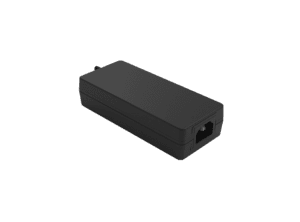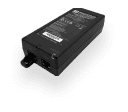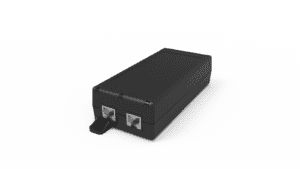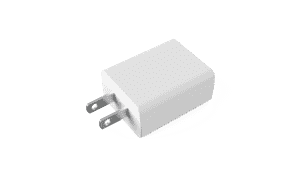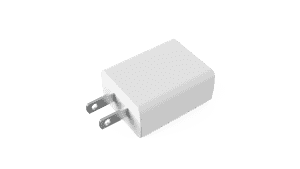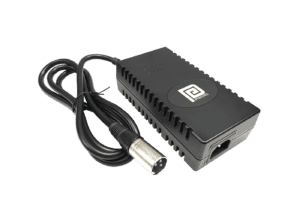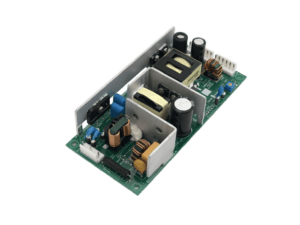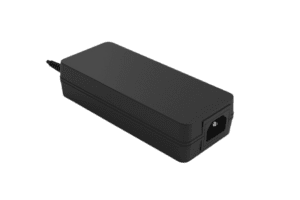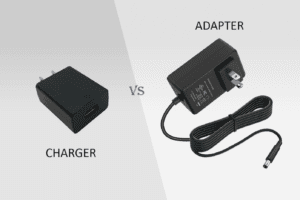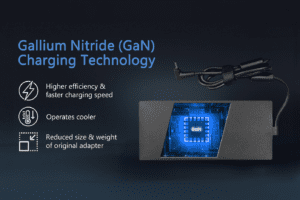BLOG
AI Data Center PSU Design: How to Create 54 V Titanium-Grade Power Shelves for GPU Clusters
QUICK LINKS

Why 54 V Power Shelves Are Critical for AI Data Center GPU Infrastructure
As artificial intelligence workloads become more compute-intensive, modern data centers must evolve to support the unprecedented power and thermal demands of GPU clusters. Traditional 12 V architectures, long the standard for data centers, are increasingly being replaced with high-efficiency 54 V power shelves to support AI-specific compute racks.
The shift to 54 V architecture is driven by the need for higher power density and reduced distribution loss. For hyperscale data centers running AI models—especially large language models (LLMs) and training clusters—the energy demand can exceed 30 kW per rack. Transmitting power at 12 V would result in massive current levels and significant copper loss. At 54 V, current is reduced and power distribution is more efficient, scalable, and thermally manageable.
GPU clusters such as those built with NVIDIA H100 or AMD MI300 accelerators operate in dense arrangements with high concurrent loads. Titanium-grade PSUs with 96%+ efficiency are essential to minimize heat and maximize power conversion at the rack level. As AI becomes central to cloud platforms, financial modeling, autonomous systems, and national research, 54 V power shelves are no longer optional—they are a next-gen requirement.
Top Features
- 54 V output architecture for high-density rack power delivery
- Titanium efficiency (96%+) for minimal energy waste
- Compatible with Open Compute Project (OCP) and rack-scale designs
Top Benefits
- Reduces copper loss and voltage drop over long power busways
- Supports 20–60 kW rack designs for AI/ML training and inference
- Improves thermal profiles for better airflow and lower cooling costs
Best Practices
- Design shelves with hot-swappable 3+1 or 6+1 PSU redundancy
- Implement advanced digital control for telemetry and power sequencing
- Validate transient performance under GPU workload load-pulsing events
The 54 V revolution in AI infrastructure is about more than efficiency—it’s about enabling scalable, high-performance computing at the edge of what’s possible.
How Titanium Efficiency Impacts Data Center Performance and ROI
Titanium-grade efficiency (96% or higher) is a game-changer for AI data centers. At scale, even a 1% improvement in conversion efficiency can result in hundreds of thousands of dollars in energy savings annually. For racks consuming 30–60 kW continuously, lower conversion losses reduce not only operational costs but also the burden on cooling systems.
In GPU-heavy workloads, power supplies experience frequent, sharp load changes. Titanium-grade PSUs deliver exceptional conversion stability and rapid transient response, ensuring consistent voltage delivery even when demand surges from idle to full throttle. This is crucial in AI model training and inference environments where voltage dips can result in errors, throttling, or system crashes.
Moreover, Titanium-grade power shelves align with broader sustainability goals. By reducing wasted energy, they contribute to data center PUE (Power Usage Effectiveness) optimization. They also require less airflow for cooling, allowing for more compact thermal zones, which is valuable in space-constrained colocation and edge deployments.
Top Features
- 96%+ conversion efficiency with minimal switching losses
- Flat efficiency curve from 10% to 100% load
- Ultra-low standby power draw
Top Benefits
- Cuts cooling and electricity costs over time
- Enables dense GPU clusters without overheating risks
- Supports sustainability and ESG reporting metrics
Best Practices
- Choose Titanium-certified PSUs compliant with 80 PLUS or equivalent standards
- Verify efficiency across a full load range using third-party data
- Combine with airflow-optimized rack designs for peak thermal synergy
Titanium isn’t just a badge—it’s an operational advantage, especially when scaled across hundreds or thousands of AI servers.
CLIENT'S QUOTE
"Phihong’s PoE solutions have made a huge difference for us! Our network runs more efficiently, and we’ve seen real cost savings. We couldn’t be happier!"
The Importance of Transient Load Response in AI GPU Environments
AI workloads—especially deep learning training—create highly volatile power demands. When thousands of GPU cores simultaneously switch from idle to active states, the power supply must respond instantly without causing voltage dips or overshoot. This is where transient load response becomes critical.
A well-engineered 54 V power shelf must maintain output voltage within narrow limits even during extreme load pulsing. Poor response times can trigger undervoltage lockouts, corrupt data, or damage sensitive silicon. Fast transient performance helps stabilize the rack’s power bus and supports safe operation of high-performance GPUs.
Designers achieve fast response through high-speed digital control loops, optimized compensation networks, and low-impedance output stages. Bulk capacitance must be calculated not just for load size, but for the speed of load transitions. High-bandwidth feedback systems and digital signal processing allow real-time control adjustments that ensure stability under AI conditions.
Top Features
- Digital voltage regulation with sub-millisecond response times
- High-bandwidth current sensing and loop compensation
- Robust bulk capacitance with low ESR characteristics
Top Benefits
- Maintains system stability during rapid load switching
- Reduces error rates in GPU clusters under AI workloads
- Supports higher utilization rates without risk of brownouts
Best Practices
- Use real workload simulation (e.g., synthetic GPU stress testing) to validate PSU design
- Evaluate loop bandwidth and compensation using digital modeling tools
- Design redundant bulk capacitors with derated voltage margins
In AI data centers, speed and stability are inseparable—and the power supply must deliver both, instantly and reliably.
How to Design for Redundancy and Hot-Swap Maintenance in 54 V Power Shelves
Redundancy and hot-swap functionality are non-negotiables in mission-critical AI data center infrastructure. In high-availability environments, GPU clusters often run 24/7, with no room for unplanned downtime. A single PSU failure should not compromise the operation of an entire rack. That’s where power shelf design must integrate N+1 or N+2 redundancy with full hot-swap capability.
A typical design includes multiple PSU modules arranged in parallel. If one fails or is removed for maintenance, the others instantly compensate without voltage drop or interruption. This modularity allows data centers to service shelves during operation—without scheduling outages or manual load transfers. PSUs must include smart controllers that communicate health status, fault conditions, and identify degraded performance before failure.
To support seamless hot-swap, connectors must be blind-mate capable and hot-plug safe, with arc suppression. Communication backplanes must support real-time polling and event logs to track PSU health in live clusters. Redundant controller designs (dual bus or mirrored logic) are ideal for enterprise and hyperscale GPU deployments.
Top Features
- 3+1, 6+1, or N+N power redundancy schemes
- Hot-swappable PSU modules with zero-downtime removal
- Intelligent status monitoring via I²C, CAN, or PMBus
Top Benefits
- Minimizes risk of system failure during PSU faults or servicing
- Reduces operational disruptions in GPU-intensive compute nodes
- Improves mean time to repair (MTTR) and overall serviceability
Best Practices
- Test full PSU failover scenarios in production-level rack simulations
- Use keyed connectors and latch mechanisms to avoid improper insertion
- Implement power-up sequencing logic to prevent inrush-related faults
Redundant, hot-swappable power shelves give AI data centers the fault-tolerant backbone needed to support non-stop machine learning operations.
How Phihong USA Supports Titanium-Grade PSU Design for AI Clusters
Phihong USA delivers advanced power shelf solutions engineered for the unique demands of AI data centers. From 54 V Titanium-grade efficiency to transient response tuning and redundancy design, we help OEMs and hyperscale operators deploy next-generation GPU infrastructure with confidence.
Our engineering teams provide:
- Modular 54 V power shelves supporting up to 60 kW per rack
- Titanium-grade power modules with 96%+ efficiency
- Full support for PMBus, CAN, and I²C telemetry integration
- Redundant controller designs and hot-swap safety validation
- Pre-compliance testing for IEC 61000-6-2, 80 PLUS Titanium, CE, and UL
Whether you’re powering GPU clusters for AI training, autonomous vehicle simulation, or enterprise inference workloads, Phihong’s solutions are ready to scale with your compute needs.
Partner with us to reduce thermal load, maximize uptime, and future-proof your AI infrastructure.
Contact us today at www.phihong.com or email usasales@phihongusa.com for a custom engineering consultation.

Contact Our Team Today!
Our dedicated sales team and international partners are prepared to support you with your latest projects and initiatives globally.
Explore More with Phihong USA
As we conclude our exploration of PoE technology, it’s evident how these innovations are streamlining power and data integration across various industries. Phihong USA stands at the forefront of this technological advancement, offering a diverse range of power solutions designed to meet the evolving needs of modern industries.
Phihong USA’s extensive product lineup includes:
- Power over Ethernet (PoE) Solutions: Delivering reliable power and data transmission over a single cable, ideal for simplifying network installations and reducing costs.
- AC/DC Adapters and Power Supplies: From compact adapters to industrial-grade power supplies, Phihong provides solutions that ensure efficiency and reliability in various applications.
- Battery Chargers: Customizable chargers for lithium-ion and lead-acid batteries, supporting a wide range of power requirements for mobility and industrial applications.
- Medical Power Supplies: Specialized power solutions designed to meet the stringent requirements of the healthcare industry, ensuring safety and reliability.
Phihong USA is committed to innovation and excellence, continually developing products that meet the highest standards of performance and reliability. Their global reach and dedication to customer support make them a trusted partner in powering the future.
Here are some useful links to explore Phihong USA’s offerings further and bring in new potential clients:
Visit Phihong USA to discover how their advanced power solutions can support your business needs. Whether you’re looking to upgrade your network, or find reliable power supplies, Phihong USA has you covered.
By choosing Phihong USA, you’re partnering with a leader in power technology, ensuring your operations run smoothly and efficiently with top-tier power solutions. Contact Us today!
FAQ
Why are 54 V power shelves preferred over 12 V in AI data centers?
54 V power shelves are preferred over 12 V designs because they offer significantly improved power distribution efficiency in high-density environments. AI data centers—especially those running GPU clusters—consume upwards of 30 to 60 kW per rack. Delivering that kind of power at 12 V would require extremely high current, resulting in excessive heat, copper loss, and cable bulk. It also puts more strain on connectors and increases voltage drop over distance.
By switching to 54 V, data centers can reduce current by more than four times for the same power delivery. This leads to:
- Lower distribution losses across busbars and backplanes
- Smaller conductor sizes and fewer thermal constraints
- Easier cable management and rack-level integration
Additionally, 54 V architectures simplify conversion to point-of-load voltages like 12 V, 5 V, or even 1.8 V through DC-DC converters near the processor or GPU. This two-stage architecture is more scalable, especially when paired with modular rack designs.
The adoption of 54 V is not only about energy savings—it’s about enabling high-efficiency, high-reliability power infrastructure that supports AI-scale loads without sacrificing uptime or safety.
What does Titanium-grade PSU efficiency mean and why is it important?
Titanium-grade efficiency refers to power supplies that meet or exceed 96% energy conversion efficiency, typically under the 80 PLUS Titanium certification or equivalent international standards. In practical terms, this means that only 4% or less of the input power is lost as heat during AC-to-DC conversion—an extremely low margin that delivers significant benefits at data center scale.
Here’s why Titanium efficiency matters for AI data centers:
- Energy savings: Reducing conversion loss directly reduces electricity bills. Across hundreds of racks, this adds up to substantial annual savings.
- Reduced cooling demand: Less heat generation means less work for HVAC and liquid cooling systems, lowering PUE (Power Usage Effectiveness).
- Higher reliability: Less heat leads to longer component life, which means fewer failures and maintenance events.
- Sustainability: Many hyperscale providers and enterprises are targeting carbon-neutral operations. Titanium PSUs support ESG goals by improving overall energy utilization.
Titanium-grade PSUs also deliver a flatter efficiency curve, maintaining high performance from light to full loads. This is particularly important in AI clusters where workloads fluctuate rapidly and power delivery must remain stable.
How does transient load response affect GPU cluster stability?
AI workloads are highly dynamic. GPUs can go from idle to peak load within milliseconds, triggering huge surges in power demand. A power supply’s transient load response—its ability to maintain stable voltage during sudden load changes—is essential to preventing crashes, data corruption, or throttling.
If a PSU can’t respond fast enough to a sudden increase in load:
- Voltage can dip below safe thresholds, causing brownouts
- GPUs may enter a fault state or reduce clock speed
- System-level instability may occur, interrupting training or inference
A well-designed Titanium-grade PSU mitigates this through:
- Fast control loops that detect and respond to current changes in real time
- Robust bulk capacitance to buffer energy during transitions
- Low ESR/ESL components that reduce impedance-induced delays
The faster and more stable the PSU responds, the more reliably AI models train and execute, particularly across distributed GPU clusters where sync errors from a single fault can ripple through the system.
What is hot-swap capability and why is it essential in AI data centers?
Hot-swap capability allows a power supply module to be inserted or removed without shutting down the system or cutting power. In AI data centers where uptime is mission-critical and clusters often run 24/7, this feature is a must.
Without hot-swap:
- PSU servicing requires powering down entire racks or diverting compute loads
- Maintenance windows must be scheduled, leading to productivity loss
- Risks of accidental data loss or process interruption increase
Hot-swappable PSU shelves are typically designed with:
- Redundancy (e.g., N+1 or N+2), ensuring that one PSU can fail or be removed without affecting operation
- Smart controllers and backplanes that automatically rebalance load during hot insertion/removal
- Arc suppression and blind-mate connectors to prevent electrical damage or insertion errors
These systems also support real-time telemetry, alerting operators to aging or degraded units before they fail. For AI applications that demand continuous throughput—from real-time inference in autonomous vehicles to long-running model training—hot-swap ensures that infrastructure stays resilient and serviceable without disruption.
How does Phihong USA support PSU design for AI-scale data center deployments?
Phihong USA helps OEMs and data center operators engineer and scale Titanium-grade 54 V power shelves specifically optimized for AI and GPU compute environments. With decades of experience in high-efficiency power solutions, Phihong delivers both standard and custom PSU designs that meet the extreme demands of AI infrastructure.
Key capabilities include:
- Titanium-certified PSUs with up to 96% efficiency
- Modular shelf systems with hot-swap and N+1 redundancy
- Digital control interfaces (PMBus, CAN, I²C) for telemetry and system-level integration
- Fast transient response performance tuned for GPU pulsed loads
- Pre-compliance testing for CE, UL, FCC, and IEC 61000 standards
Phihong also offers engineering support for rack-level power architecture, helping partners with thermal modeling, airflow optimization, and shelf integration into Open Compute Project (OCP) platforms.
Whether your use case is deep learning model training, hyperscale inference, or edge GPU compute, Phihong’s team can help you accelerate development, reduce energy costs, and ensure long-term reliability of your AI-ready power infrastructure.
To get started, contact sales@phihongusa.com or visit www.phihong.com.

